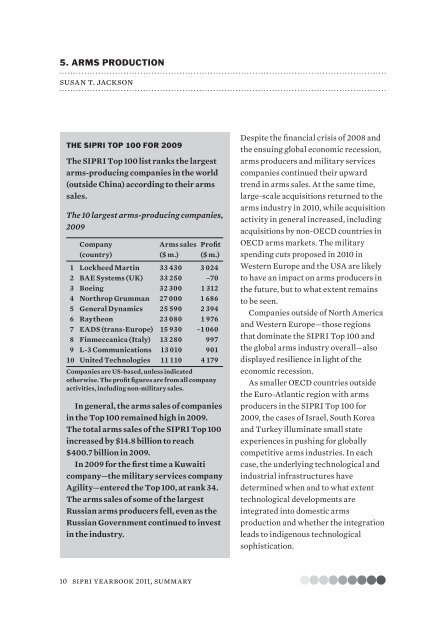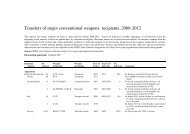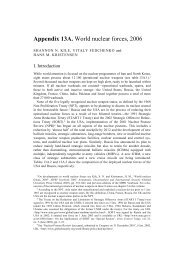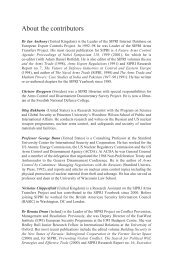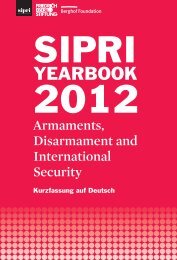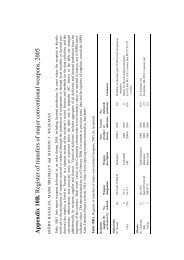SIPRI Yearbook 2011: Armaments, Disarmament and International ...
SIPRI Yearbook 2011: Armaments, Disarmament and International ...
SIPRI Yearbook 2011: Armaments, Disarmament and International ...
Create successful ePaper yourself
Turn your PDF publications into a flip-book with our unique Google optimized e-Paper software.
5. Arms PRODuctIOn<br />
susan t. jackson<br />
The <strong>SIPRI</strong> tOP 100 fOR 2009<br />
The <strong>SIPRI</strong> Top 100 list ranks the largest<br />
arms-producing companies in the world<br />
(outside China) according to their arms<br />
sales.<br />
The 10 largest arms-producing companies,<br />
2009<br />
Company<br />
Arms sales Profit<br />
(country) ($ m.) ($ m.)<br />
1 Lockheed Martin 33 430 3 024<br />
2 BAE Systems (UK) 33 250 –70<br />
3 Boeing 32 300 1 312<br />
4 Northrop Grumman 27 000 1 686<br />
5 General Dynamics 25 590 2 394<br />
6 Raytheon 23 080 1 976<br />
7 EADS (trans-Europe) 15 930 –1 060<br />
8 Finmeccanica (Italy) 13 280 997<br />
9 L-3 Communications 13 010 901<br />
10 United Technologies 11 110 4 179<br />
Companies are US-based, unless indicated<br />
otherwise. The profit figures are from all company<br />
activities, including non-military sales.<br />
In general, the arms sales of companies<br />
in the Top 100 remained high in 2009.<br />
The total arms sales of the <strong>SIPRI</strong> Top 100<br />
increased by $14.8 billion to reach<br />
$400.7 billion in 2009.<br />
In 2009 for the first time a Kuwaiti<br />
company—the military services company<br />
Agility—entered the Top 100, at rank 34.<br />
The arms sales of some of the largest<br />
Russian arms producers fell, even as the<br />
Russian Government continued to invest<br />
in the industry.<br />
Despite the financial crisis of 2008 <strong>and</strong><br />
the ensuing global economic recession,<br />
arms producers <strong>and</strong> military services<br />
companies continued their upward<br />
trend in arms sales. At the same time,<br />
large-scale acquisitions returned to the<br />
arms industry in 2010, while acquisition<br />
activity in general increased, including<br />
acquisitions by non-OECD countries in<br />
OECD arms markets. The military<br />
spending cuts proposed in 2010 in<br />
Western Europe <strong>and</strong> the USA are likely<br />
to have an impact on arms producers in<br />
the future, but to what extent remains<br />
to be seen.<br />
Companies outside of North America<br />
<strong>and</strong> Western Europe—those regions<br />
that dominate the <strong>SIPRI</strong> Top 100 <strong>and</strong><br />
the global arms industry overall—also<br />
displayed resilience in light of the<br />
economic recession.<br />
As smaller OECD countries outside<br />
the Euro-Atlantic region with arms<br />
producers in the <strong>SIPRI</strong> Top 100 for<br />
2009, the cases of Israel, South Korea<br />
<strong>and</strong> Turkey illuminate small state<br />
experiences in pushing for globally<br />
competitive arms industries. In each<br />
case, the underlying technological <strong>and</strong><br />
industrial infrastructures have<br />
determined when <strong>and</strong> to what extent<br />
technological developments are<br />
integrated into domestic arms<br />
production <strong>and</strong> whether the integration<br />
leads to indigenous technological<br />
sophistication.<br />
10 sipri yearbook <strong>2011</strong>, summary


